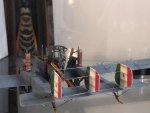Sid Guttridge
New Member
On 6 January he Daily Telegraph published an obituary of Francesco Volpi.
He had been born under Austro-Hungarian rule in 1914. He learnt to fly in 1935 on a Ca.100 biplane and at one point his commanding officer was Italo Balbo.
At the outbreak of war he was serving with the airline Ala Litoria, which performed commercial and transport duties as far away as South America and Ethiopia. (Whether Volpi flew that far is unclear). He then joined the bomber force.
"In 1941....he was posted to Russia with the 246th Squadron, equipped with three-engined Savoia-Marchetti SM79s and 81s. The following year he was awarded the Bronze Medal for Valour.
He was also given the Iron Cross after flying a group of high-ranking German officers into Stalingrad, then encircled by the Soviets. Volpi vividly recalled landing under fire on a makeshiftt airstrip.
He returned to Italy with more than 20 metal splinters in his body and would fly a total of 236 operational missionms during the war.
Volpi subsequently served in the Mediterranean, tracking British ships off North Africa and later became involved in a secret scheme for a long-range bomber attack on New York. This was forestalled by the Italian forces' exit from the war.
He managed to avoid being rounded up by the Germans at Vicenza station after swapping clothes with a railwayman."
At the time of his death in November 2019, he was believed to be the oldest person still holding a valid pilot's licence. He flew a dual control aircraft every year on his birthday until the year before his death at 105.
It strikes me that a pilot who survived 236 bomber missions in Italy's wartime air force must have been both highly skilled and incredibly lucky!
Does anyone know anything about the proposed Italian air raid on New York?
Cheers,
Sid.
He had been born under Austro-Hungarian rule in 1914. He learnt to fly in 1935 on a Ca.100 biplane and at one point his commanding officer was Italo Balbo.
At the outbreak of war he was serving with the airline Ala Litoria, which performed commercial and transport duties as far away as South America and Ethiopia. (Whether Volpi flew that far is unclear). He then joined the bomber force.
"In 1941....he was posted to Russia with the 246th Squadron, equipped with three-engined Savoia-Marchetti SM79s and 81s. The following year he was awarded the Bronze Medal for Valour.
He was also given the Iron Cross after flying a group of high-ranking German officers into Stalingrad, then encircled by the Soviets. Volpi vividly recalled landing under fire on a makeshiftt airstrip.
He returned to Italy with more than 20 metal splinters in his body and would fly a total of 236 operational missionms during the war.
Volpi subsequently served in the Mediterranean, tracking British ships off North Africa and later became involved in a secret scheme for a long-range bomber attack on New York. This was forestalled by the Italian forces' exit from the war.
He managed to avoid being rounded up by the Germans at Vicenza station after swapping clothes with a railwayman."
At the time of his death in November 2019, he was believed to be the oldest person still holding a valid pilot's licence. He flew a dual control aircraft every year on his birthday until the year before his death at 105.
It strikes me that a pilot who survived 236 bomber missions in Italy's wartime air force must have been both highly skilled and incredibly lucky!
Does anyone know anything about the proposed Italian air raid on New York?
Cheers,
Sid.


